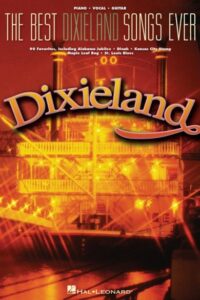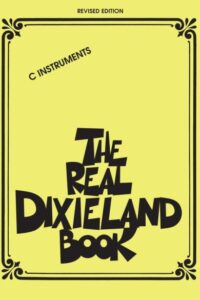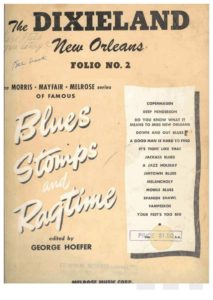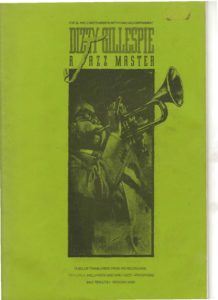Table of Contents
Come join us now, and enjoy playing your beloved music and browse through great scores of every level and styles!
Can’t find the songbook you’re looking for? Please, email us at: sheetmusiclibrarypdf@gmail.com We’d like to help you!
Dixieland Big Band (Authentic) Book Original Arr. for Dixieland Band

Best Sheet Music download from our Library.

Please, subscribe to our Library.
If you are already a subscriber, please, check our NEW SCORES’ page every month for new sheet music. THANK YOU!
What is the Dixieland jazz style?
The Joyful Noise: A Journey into the Heart of Dixieland Jazz
In the tapestry of American music, few threads are as vibrant, enduring, and fundamentally joyous as Dixieland jazz. It is the sound of a collective celebration, a musical conversation where every instrument has a voice, and the primary goal is to lift spirits. Often called “Traditional Jazz” or “New Orleans Jazz,” Dixieland is more than a genre; it is the root from which the mighty tree of jazz grew. It is a spirited, polyphonic chaos that resolves into perfect harmony, a sound that evokes images of street parades, smoky dance halls, and the relentless, pulsating life of its birthplace.
This is the story of that sound—of its origins, its structure, its legendary creators, and its undying appeal.
The Cradle of Jazz: New Orleans at the Turn of the Century

Browse in the Library:
Or browse in the categories menus & download the Library Catalog PDF:
To understand Dixieland, one must first understand the unique cultural crucible that was New Orleans around the dawn of the 20th century. A port city teeming with a mix of African, Caribbean, French, Spanish, and Anglo-American influences, it was a place where musical traditions collided and fused.
- African Rhythmic Heritage: The complex rhythmic patterns and the concept of call-and-response, central to West African music, were preserved and evolved in Congo Square and in the everyday life of Black New Orleanians.
- European Harmonic Structure: Brass bands, military marches, and French and Italian operatic melodies provided the harmonic and melodic framework. Instruments like the cornet, clarinet, trombone, and tuba were readily available from military surplus stores.
- The Blues: The raw, emotive, and deeply personal expression of the Delta Blues seeped into the city, providing the essential “feel” and harmonic progression that would become a jazz staple.
- Ragtime: The syncopated, piano-based music of Scott Joplin and others taught musicians how to “rag” a melody, to play it with a swung, off-beat rhythm.
From this stew emerged a new music. It was played everywhere: in funeral processions (playing solemn dirges on the way to the cemetery and joyous, raucous tunes on the way back), in dance halls, in brothels of Storyville, and in parks. It was functional music, meant for dancing and communal catharsis.
The Architecture of Joy: The Dixieland Sound

What distinguishes Dixieland from other forms of jazz is its polyphonic, or multi-voiced, texture. Unlike later jazz forms where a single soloist takes the spotlight over a rhythm section, classic Dixieland is a continuous, simultaneous ensemble performance. It’s a democratic chaos where everyone is talking at once, but somehow, it all makes sense.
A typical Dixieland band is built around a frontline and a rhythm section.
The Frontline (The Melodic Voices):
- Cornet/Trumpet: The leader of the pack. The cornet (or later, trumpet) plays the melody, or “lead.” Its job is to state the tune clearly and with authority, providing the musical anchor around which the others weave.
- Clarinet: The florid obbligato. The clarinetist plays a soaring, twisting, and ornate counter-melody above the cornet line. It provides brilliance, agility, and a sense of playful complexity.
- Trombone: The rhythmic and harmonic glue. The trombonist provides the “tailgate” style—filling in the harmonic gaps with glissandos (slides) and playing a rhythmic, chord-based line that outlines the harmony below the cornet. The name “tailgate” comes from early bands where the trombonist would sit on the tailgate of a wagon to have room for his slide.

The Rhythm Section (The Engine Room):
- Piano/Banjo: Provides the chordal accompaniment and rhythmic pulse. The banjo (or later, guitar) offers a sharp, percussive chordal attack, while the piano adds harmonic richness and a fuller sound.
- Tuba/String Bass: The “bull fiddle” or tuba was the original bass instrument, providing a strong, marching band-style oom-pah foundation. Later, the string bass (double bass) replaced it, offering a more flexible and walking bass line.
- Drums: The timekeeper. The drummer keeps the beat steady and adds rhythmic color with press rolls, woodblock hits, and cymbal crashes, driving the band forward.
The magic happens in the collective improvisation. The frontline weaves these three distinct lines—melody, counter-melody, and harmonic rhythm—into a thrilling, cohesive whole. It’s a musical high-wire act that requires incredible listening and interplay.
The Titans: The Musicians Who Built the Tradition
Dixieland was forged by a generation of musical pioneers, many of whom were born within a few years and miles of each other in New Orleans.
The Founding Fathers:
- Buddy Bolden (1877-1931): A mythical figure, often called “the first man of jazz.” A powerful cornetist, his band was legendary in New Orleans around 1905, though he never recorded. His style was a raw, powerful blend of blues and improvisation, and his influence was immense on every musician who heard him.
- Freddie Keppard (1889-1933): Bolden’s successor as the “king” of New Orleans cornet. He was a more technically proficient player than Bolden and led the famous Original Creole Orchestra, which was one of the first jazz bands to tour nationally, bringing the sound out of New Orleans.
- Jelly Roll Morton (1890-1941): A brilliant pianist, composer, and arranger—and a colossal braggart who claimed to have “invented jazz in 1902.” While the boast was hyperbolic, his contributions were profound. He was among the first to formally arrange jazz music, seamlessly blending composed sections with improvisation. His compositions like “King Porter Stomp” and “Black Bottom Stomp” are Dixieland masterpieces.
The First Generation of Recorded Stars:
The moment that catapulted jazz onto the national stage was the first recording by the Original Dixieland Jass Band in 1917. This was a group of white New Orleans musicians who brought a polished, frantic, and highly influential version of the music to New York. While they were not the first to play jazz, they were the first to record it, and their records like “Livery Stable Blues” became nationwide sensations.
Soon after, the great Black pioneers of the music began to record, and their artistry defined the genre for all time.
- King Oliver (1885-1938): A master cornetist and a revered mentor. His Creole Jazz Band, featuring…
- Louis Armstrong (1901-1971): …his young protégé, was the most formidable band in jazz in the early 1920s. Oliver’s use of mutes for “wah-wah” effects was revolutionary. But it was his second cornetist, Louis Armstrong, who would change everything. Armstrong’s unparalleled genius, his powerful tone, and his revolutionary sense of rhythm and melody began to push the music from collective improvisation toward the soloist-focused style that would define the Swing Era. His recordings with his groups, the Hot Five and Hot Seven, are the absolute canon of Dixieland.
- Johnny Dodds (1892-1940) & Kid Ory (1886-1973): The quintessential clarinetist and trombonist of the era. Dodds, who played with Oliver and Armstrong, possessed a fiery, blues-drenched tone that was the perfect clarinet counterpoint. Kid Ory was the master of tailgate trombone, with a robust sound and impeccable timing. His career enjoyed a major revival during the Dixieland resurgence of the 1940s and ‘50s.
The Second Line: Revivalists and Keepers of the Flame
As jazz evolved into swing and bebop, the original Dixieland style was overshadowed. But in the late 1930s and 1940s, a “Dixieland Revival” began, spearheaded by fans and musicians who sought to preserve the traditional sound.
- Lu Watters (1911-1989) and the Yerba Buena Jazz Band: In San Francisco, Watters meticulously recreated the sound of King Oliver’s band, inspiring a whole new generation of traditionalists.
- Turk Murphy (1915-1987): A trombonist from Watters’s band who went on to lead his own hugely successful traditional band.
- Eddie Condon (1905-1973): A guitarist and impresario in New York who hosted legendary jam sessions and concerts, featuring a who’s who of white traditionalists like trumpeter Wild Bill Davison (known for his aggressive, “freight train” style) and guitarist Bud Freeman.
- The Dukes of Dixieland: A family band from New Orleans that became incredibly popular in the 1950s and 60s, recording prolifically and bringing the music to a wide audience.
The Enduring Spirit of Dixieland
Why does Dixieland, a music born over a century ago, continue to captivate audiences?
- Inexhaustible Energy: It is fundamentally happy, upbeat music. Its primary purpose is to make you tap your foot, smile, and dance. In a complex world, its direct, joyful communication is powerful.
- Democracy in Action: The collective improvisation is a thrilling listen. It’s a model of controlled chaos, a musical metaphor for individuals working together to create something greater than themselves.
- Accessibility: The melodies are often familiar tunes or simple, catchy themes. The energy is immediate and unpretentious. It doesn’t require deep musical knowledge to appreciate; it speaks directly to the soul.
- A Living Tradition: From the preservation halls of New Orleans to jazz clubs and festivals across the globe, musicians continue to play this music. While honoring the traditions, they inject their own personality and spirit into it, keeping it alive and evolving.
Dixieland is not a museum piece. It is the original sound of jazz—a bold, rebellious, and exultant noise that erupted from the streets of New Orleans and captured the spirit of a nation. It is the sound of collective joy, a reminder that from many voices, one glorious, swinging conversation can emerge. To listen to Dixieland is to hear the very heart of American music, still beating strong.
Search your favorite sheet music in the category of Jazz, Blues, Soul, & Gospel.

